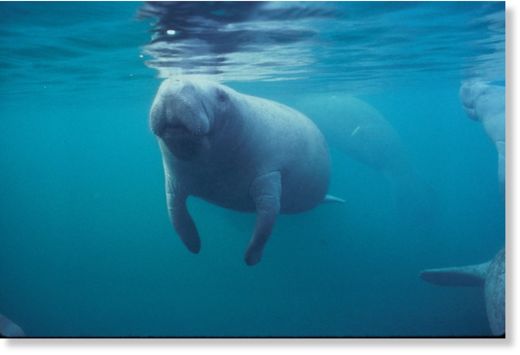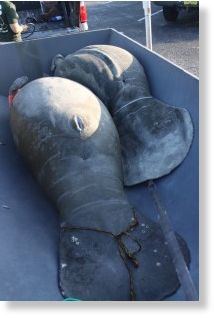
But despite widespread media coverage implying the case is all but closed, the toxins are just one of many clues in a complicated case. Before the toxins can be linked to the deaths, there are many crucial questions that need answers - including whether the compounds are found in the carcasses.
Since last July, 111 manatees, 51 dolphins, and as many as 300 pelicans have died in the northern Indian River Lagoon. Scientists studying the situation are still trying to find the culprit, or culprits, behind the deaths; at this point, they're not even sure the die-offs are all the work of the same killer. The manatees, which normally eat sea grass, die quickly - but their outward appearance doesn't give any clues to what killed them.
Dolphins and pelicans, on the other hand, normally eat fish, and unlike the manatees, their carcasses show signs of starvation and emaciation.
The latest development comes from Peter Moeller, an organic chemist who works with NOAA's National Ocean Service and is an expert at finding and identifying unknown toxins running around in ecosystems.
"My role is to isolate, purify, and structurally characterize those toxins or chemicals that are implicated in some environmental or human health event," he said. "If we know what they are, we might be able to do something about it."
In late May, Moeller was given several pounds of Gracilaria algae from the northern lagoon. This type of seaweed has been found in the stomachs of dead manatees. The marine mammals may be eating it because the seagrass they prefer started disappearing from the lagoon in 2011.
Moeller ground up the Gracilaria and took some extracts from the mash. Then, he checked for toxicity by introducing the extracts to two types of mammalian cells: mouse brain cells and human breast cancer cells. The extract killed both types of cells, suggesting that something - perhaps in the algae, or in the microbes clinging to it - was toxic.
To search for potential toxins in the extracted soup, Moeller performed a series of standard analytic chemistry procedures that would separate the mixture's ingredients. Eventually, he identified three "suites" of toxins in the algal extracts.
When he applied the toxins - at a concentration that could exist in nature - to the mammalian cells, the cells died. When he tested the toxins on brine shrimp (which you may know as Sea Monkeys, if you had them as a kid), the shrimp died, too.
Moeller says he's pretty sure two of the suites correspond to one toxin each; the third is at least one toxin, but could be as many as hundreds. None of the toxins have been identified yet - they're all unknowns. "I doubt very much they're from the same organism," Moeller said. He suspects that rather than being produced by the Gracilaria itself, the toxins are coming from microbes that cling to the algae. But it's too soon to say for sure.
It's easy to see why these results could be misinterpreted as identifying the culprit behind the manatee die-off: Finding lethal compounds associated with the seaweed that manatees are eating seems like a pretty solid connection. But it's only circumstantial. Despite what you may have read elsewhere, Moeller's work is simply another clue about what might be going on in the lagoon.
First, finding an unidentified toxin in an ecosystem, especially one where algae proliferate, is not really that surprising. In fact, Moeller says, there are likely to be many unidentified toxins in an ecosystem like the Indian River Lagoon. That's because microbes hitching a ride on larger algal species, and the algae themselves, are engaged in a perpetual chemical arms race with their competitors. "They're constantly fighting," Moeller said. "They create secondary metabolites, or toxins, to ward off other algae or other bacteria to stay alive." This means that the substances they produce - such as toxins - are constantly modified and mutated, more quickly than science can keep up.
Second, and most important, the toxin responsible for the animals' deaths needs to be found in the animals themselves, in the tissues or organs that have been compromised. So far that has not happened.
Just because something toxic has been found in association with Gracilaria doesn't mean that toxin is the culprit. These animals are all living or diving in the lagoon's water, which probably hosts an army of potentially toxic stuff. "Manatees are also drinking water that is full of toxins," Moeller notes.
There are many steps that need to be taken before the compounds in the lab can be linked to the animal die-offs, including figuring out what they actually are. When Moeller identifies the toxins, he'll hand off the investigation to a different set of scientists, who will then look for a more direct link between the toxins and the carcasses.
"When it's all said and done, I believe we can at least home in on a genera, or maybe a species, of algae that are potentially the producers," Moeller said. But until researchers start finding one of those toxins in the dead manatees, or in the guts of a dead dolphin or pelican, it's still an open case.




Reader Comments
to our Newsletter